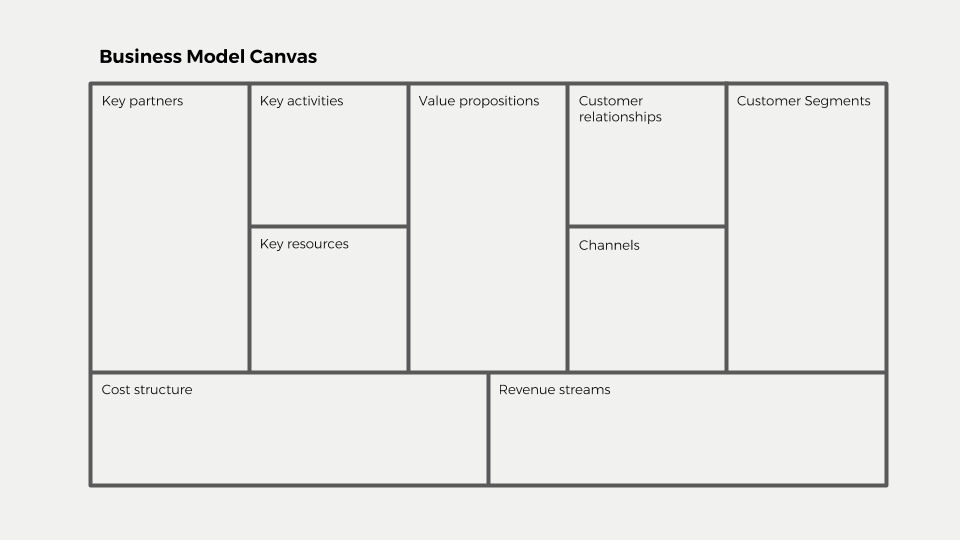What is a Business Model?
When you start your company one major question you need to answer is how to organize your startup. Usually, the first reaction and response to this question is an organization chart. This is not what you need at this stage of your business and you need to think in terms of what your business is going to do, how you going to deliver your service or product to your customer, marketing strategies, partners, etc.
In other words, the best way to think about how you want to organize your startup is by a business model. OK, but what exactly is a Business Model?
A Business Model is how a company creates value for itself by delivering products or services for its customers.
To present all the bits and pieces in a business model, we will use a structure called “Business Model Canvas”.
Business Model Canvas explained
 The Business Model Canvas comprises of 9 boxes. Each of these boxes represents an activity, goal or relationships, or resources your startup needs to execute or fulfill in order to create value. In these boxes, you will describe the different pieces of your startup.
The Business Model Canvas comprises of 9 boxes. Each of these boxes represents an activity, goal or relationships, or resources your startup needs to execute or fulfill in order to create value. In these boxes, you will describe the different pieces of your startup.
Value proposition
Value proposition defines what you are building and for who. This is not about your idea what the product is, it is about solving a problem (a need or want) for customers. Value proposition defines the pain, the need, or want you are solving for a very specific set of customers.
Make sure you are describing what the customers will get out of your service or product and how you plan to improve their lives. Be careful not to turn this into talk about your technology. This is a common mistake that many startups make. Customers don’t care about your technology. It is only the means to deliver your solutions, but it should never be the center of your business model and your value proposition. The technology is just part of the value proposition, at best. It may be an important part, but still only a part of it.
Customer Segments
Who are your customers and why would they buy from you. You need to figure out the geographic, demographics, social characteristics of your customers.
We reviewed one method (the SPA method) to help you define your customer segments. Please review the post “How To Determine Your Customer Segments Using The SPA Method” for a detailed description.
Just remember that any methodology and research you do is just a hypothesis, nothing more. You will learn and need to adjust, once you start selling your product. The more you know about your customers the closer your hypothesis will be to the truth and the higher the chance of success for your product or service upon market introduction.
Channels
How do you successfully distribute your offering, also referred to as your “Value Proposition,” to your target market?
In the current business environment, marketing endeavors now span beyond traditional, physical channels, with a cornucopia of digital platforms taking the lead. For businesses in their infant stages, it’s imperative to strategize the dissemination of your services or products and to manage their delivery. A crucial part of this is formulating a roadmap detailing the relationships between various channels, prioritizing them, and effectuating their development systematically.
Customer Relationships
Consider the following elements when crafting your customer relationship strategy
- Techniques for attracting customers
- Methods to maintain customer loyalty
- Strategies to broaden your customer reach
.This step encompasses developing strategies for customer procurement through a diverse range of platforms including websites, mobile apps, and physical stores. Retention strategies are equally important to ensure your customer base remains stable. Actions such as streamlining login procedures, providing rewards, offering captivating features, and running promotional campaigns all serve to enhance customer engagement and motivate them to maintain their relationship with your brand. It’s here that upsell strategies come in handy, providing the incentive for increased spending, thereby maximizing profits and reinforcing customer loyalty.
Mitigating churn is integral to solidifying the foundation of your startup. Naturally, including growth mechanisms within your strategy is a necessity to enhance your customer reach
Revenue Streams
Grasping how to profit from your products and services sold to distinct Customer Segments is crucial.
This exercise involves the construction of a revenue model: How will you effectively capture value from the services you deliver to your customers? What pricing structure should you follow? Which pricing approach – monthly subscription, pay-per-use, freemium model, or a mixed model, aligns best with your value proposition?
Like any other elements of the Business Model Canvas, these are simply business model theories for your startup. Uncovering the perfect model necessitates relentless experimentation and unfettered innovation in business. Rigorously test, learn, and refine until you discover the ideal business model that propels your enterprise’s growth.
Resources
.An emerging startup requires a compass of critical assets to breathe life into their business blueprint, making it not only operational but prosperous. Such assets play a pivotal role in enabling the startup to produce, distribute, and deliver their offerings to customers effectively, creating an avenue for wealth generation.
The indispensable resources can take many forms, from finances, delivery vehicles, production machinery, all the way to intellectual properties like patents, uniquely qualified team members, and client databases. It’s essential for the startup business to be clear and specific about what resources it needs to ignite and sustain its functions.
Partners
This section provides an avenue to identify and describe the crucial partners and suppliers that your startup will rely on to pave the path toward a profitable business structure.
Mastering the fine art of forging partnerships necessitates a thorough comprehension of the benefits you intend to reap from these relationships. Various factors come into play in such agreements, such as the needed services, specific skill sets, customer reach, and any intellectual property that your business can leverage through these strategic tie-ups.
A part of partnership administration lies in acknowledging the critical roles your partners play for your startup. Possessing a solid comprehension of these roles amplifies the value derived from these alliances.
Without a doubt, such partnerships represent pivotal decisions for new startups. When stepping into such agreements, your team needs a firm understanding of their lifecycle. This timeframe awareness is vital since your startup requirements at the onset likely won’t remain stagnant a couple of years down the line.
This space provides an ideal opportunity to carve out strategic partnerships with non-competitors, create joint ventures, and build a robust network of suppliers and buyers.
Activities
What constitutes the startup’s main activities that breathe life into the business blueprint?
The activities will vary based on the nature of your startup’s operations. Whether it’s manufacturing or offering consulting services, understanding these activities is instrumental to know where to exert efforts to attain growth, awareness, and customer satisfaction effectively.
Costs
Firstly, you should concentrate on recognizing and detailing all operation-related costs and expenses.
Over and above routine expenses such as rent and supplies, it’s imperative to plan effectively. What are the most essential costs associated with your startup? These are the inescapable expenses that directly impact your business procedures. Without doubt, you’ll want to identify your most expensive assets and principal activities.
This segment is particularly useful when propelling your startup towards funding as it provides a clear picture of the financing you need and how it will be distributed.
Conclusion
The Business Model Canvas is a remarkably robust instrument for a startup to define its business strategy. By bringing together the nine unique facets of a company’s framework within the canvas, it aids you, the entrepreneur, in comprehending the vital decisions you need to take, where your immediate concentration must be, and develop a tangible action plan. It provides a strategic outlook and long-haul plans like potential alliances, customer acquisition, and retention tactics, amongst others.
The most efficient way to formulate your Business Model Canvas is to plot it on a large surface to enable team-wide review and idea generation. This could become an enjoyable task and even trigger fascinating discussions. Encourage your advisors to scrutinize your Business Model Canvas and consider their feedback. Forming this model before meeting with your advisors can lead to incredibly valuable and focused dialogues. The Business Model Canvas is an indispensable initial move for every startup.
One resourceful tool I have discovered, which may be useful in shaping your Business Model Canvas, is Canvanizer. This platform facilitates describing the business model, recognizing operational costs, planning funding for startup, and reviewing the team process, thereby simplifying major decision-making.



0 Comments